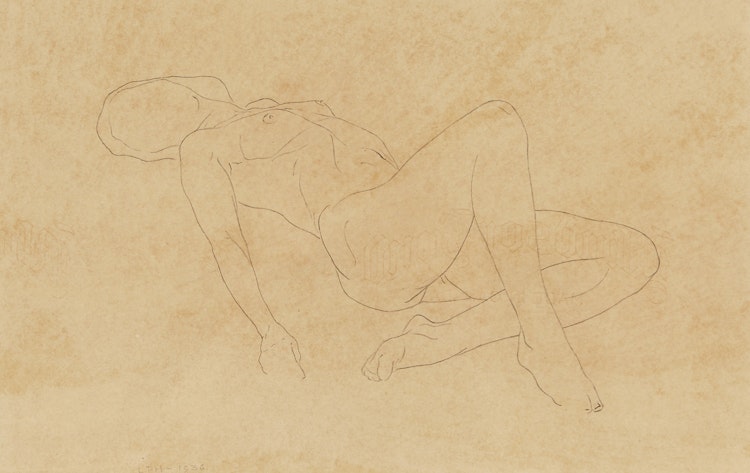Female Nude by Lawren Phillips Harris

Lawren P. Harris
Female Nude
graphite on paper
signed with initials and dated 1936
8.25 x 12.5 ins ( 21 x 31.8 cms ) ( sight )
Auction Estimate: $400.00 - $600.00
Price Realized $1,610.00
Sale date: June 14th 2017
Share this item with your friends
Lawren Phillips Harris
(1910 - 1994)
Born in Toronto, Ontario, his parents provided him with an artistically rich background. He attended Upper Canada College, Trinity College School and Pickering College. At his father’s studio and at home he was stimulated by the conversations of the Group of Seven. From his father (Lawren S. Harris) he learned much about painting but his formal training was received at the Central Technical School, Toronto, and at the Boston Museum of Fine Arts. He received valuable criticism from his father and from A.Y. Jackson. He spent five or six years working with the human form and then turned to landscapes which he painted in a highly topographical manner. He then began to formalize his subject matter and to reduce the amount of detail and explained this phase as follows, “These rather austere renderings, tended to become somewhat geometric and cubistic, and I became excited by the resulting shapes, forms and patterns, for their own sake, and which now seemed to me to exist in their own right … Such generalization, soon evolved into decorative symbolism, where an area of farm-land yielding various crops, resembled smoothly-flowing colourful rugs, over-laying a gently-contoured earth feature. The depictions, perhaps reminiscent of Grant Wood, finally led me to the verge of semi-abstraction – but, as the Second World War had developed in earnest, I left my studio for a tank.”
Harris served as a lieutenant in Canada and Great Britain 1940-43 and in 1943 was appointed an official Canadian army war artist with the rank of captain. In this capacity he served in Great Britain, Italy and Canada (1943-46). In Italy he worked for a time alongside Captain Charles Comfort. He had been sent as a replacement for Captain W.A. Ogilvie who had accompanied the 1st Canadian infantry Division during its landing in Italy and its subsequent advances. Ogilvie returned to the United Kingdom, where he was to continue his outstanding record. Near Ortona Comfort and Harris worked together.
From his highly realistic war paintings he moved into the field of abstraction once more and explained, “…having been appointed a war artist, and more or less obliged to paint for the paymaster in a rather heroic and starkly realistic fashion, I became more than ever convinced that some form of abstraction would be my eventual mode of expression. This conviction partly prompted me to execute a small number of semi-abstract drawings of war-ravaged buildings, for personal reasons this being the subject which moved me the most at the time. Prior to my release from the army, I also made a large series of non-objective drawings, four of which later provided the material for my first post-war paintings … they served their existence by paving the way for the group of total abstractions to follow.”
In 1946 Harris visited the Guggenheim Museum in New York where he was greatly impressed with the work of Kandinsky and others. When he returned to Toronto he embarked on a series of non-objective studies. Harris did several paintings at one time and found that each assisted the other. He relied on a planned approach based upon a series of studies.
Before the Second World War he taught at the Northern Vocation School, Toronto (1936-39); Trinity College School, Port Hope (1939-40) and following the war became Director at the Mount Allison School of Fine and Applied Arts, Sackville, N.B. In 1961 he was appointed a professor of Fine Arts and Head of the Fine Arts Department at Mount Allison University. Harris was one of Canada’s greatest portrait painters, as well as a muralist. He is represented in the National Gallery of Canada, the Art Gallery of Ontario the Beaverbrook Art Gallery and many others. He was a member of the Canadian Group of Painters (1936); Ontario Society of Artists (1938) and the Royal Canadian Academy (A.R.C.A. 1947). He lived at Sackville, N.B.
Source: "A Dictionary of Canadian Artists, Volume II”, compiled by Colin S. MacDonald, Canadian Paperbacks Publishing Ltd, Ottawa, 1979

